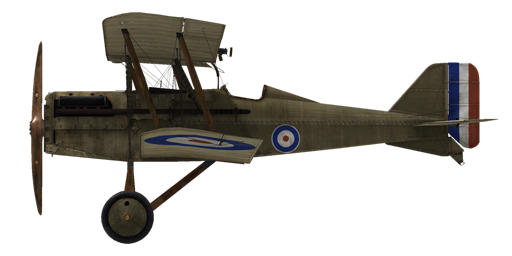il2
S.E.5a

Description
The S.E.5a (single-seat fighter, Scout Experimental 5a) was designed by the British company known as R.A.F. (Royal Aircraft Factory). The goal was to build a fighter around the 200hp Hispano-Suiza engine, which would make it to be fast and have a high climbing speed. To achieve this goal, engineers had to settle on a compromise. By making the wing profile thin, they simultaneously increased its surface area. This design featured ailerons in both the upper and lower wings. In total, 5269 planes were built by the end of the war.
The plane’s first trial flight was performed in January 1917, and it saw action in June 1917 at the British No. 56 Squadron RFC. It was used to engage enemy fighters and balloons and to escort bombers; only rarely was it used to engage ground targets near the front lines. In evaluating the aircraft, pilots mentioned its structural durability, sufficient manoeuvrability, stability in dives and when firing machine guns, fine handling, and good sensitivity of controls at low speeds. When landing at high speed, the plane could not touch down due to its high wing lift. It is notable that most of the top British aces flew this type of plane. It was even given a nickname - “ace-maker.”
During the aircraft’s service, the poor reliability of the Hispano-Suiza engine became apparent; as a result, the plane was also fitted with the more reliable Wolseley Viper engine (license-built by the British Hispano-Suiza factories). The landing gear structure had to be redesigned after frequent reports were made of it breaking upon landing. This involved changing its shape (metal welded tubes were replaced by a wooden frame). The aircraft participated in battles in Europe on the Western Front and in Macedonia and also in Mesopotamia and Palestine.
Engine V8 Wolseley Viper 200 HP
Dimensions
Height: 2743 mm
Length: 6300 mm
Wing span: 8000 mm
Wing surface: 23.7 sq.m
Weight
Empty: 635 kg
Takeoff: 886 kg
Fuel capacity: 148 l
Oil capacity: 16 l
Maximum airspeed (IAS)
sea level — 223 km/h
1000 m — 209 km/h
2000 m — 194 km/h
3000 m — 180 km/h
4000 m — 165 km/h
5000 m — 150 km/h
6000 m — 133 km/h
Climb rate
1000 m — 2 min. 52 sec.
2000 m — 6 min. 15 sec.
3000 m — 10 min. 41 sec.
4000 m — 17 min. 03 sec.
5000 m — 28 min. 01 sec.
Service ceiling 5500 m
Endurance at 1000 m
nominal power (combat) — 2 h. 10 min.
minimal consumption (cruise) — 6 h. 10 min.
Armament
Forward firing: Vickers Mk.I 7,69 mm, 400 rounds per barrel.
Forward firing (wing mounted): Lewis 7,69 mm, 4 drums per 97 rounds each.
Bomb load: 36 kg bomb.
References
1) The Royal Aircraft Factory, by Paul R Hare.
2) S.E. 5a in action. Squadron/signal publications, Aircraft Number 69.
3) RAF S.E.5 and S.E.5a Specification.
4) Profile Publications, The S.E. 5A Number 1.
Modifications
Cooper bombs
Up to 4 x 11 kg (24 lb) Cooper General Purpose Bombs
Additional mass: 56 kg
Ammunition mass: 44 kg
Racks mass: 12 kg
Estimated speed loss before drop: 2 km/h
Estimated speed loss after drop: 1 km/h
Cockpit light
Cockpit illumination lamp for night sorties
Additional mass: 1 kg
Aldis
Aldis Refractor-type Collimator Sight
Additional mass: 2 kg
Fuel Gauge
Needle Scale fuel level Gauge (0-30 Gallons)
Additional mass: 1 kg